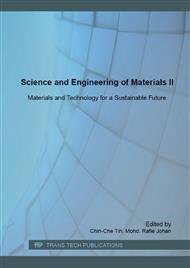p.112
p.117
p.122
p.127
p.132
p.138
p.143
p.148
p.154
Microstructural Study of Leached Nitrided Malaysian Ilmenite with Coal-Polystyrene Reductant
Abstract:
Titanium oxycarbonitride (TiOxCyNz) produced from Malaysian ilmenite consists of impurities such as iron that adversely affect the efficiency of chlorination process. In this paper, the dissolution of iron present in TiOxCyNz was performed using ammonium chloride (NH4Cl) solution at 70 °C from 4-6 hrs. Effects of acid concentration, catalyst amount and leaching time on the rate of iron dissolution were also investigated. Microstructural and/or morphological studies of the raw materials, and products were carried out by X-ray diffraction (XRD), X-ray Fluorescence (XRF), scanning electron microscopy (SEM), and Energy Dispersive X-ray analysis. The results obtained from SEM/EDX analysis for the reduced samples HR15 (15% Polystyrene (PS) + 85% coal (C)), HR25 (25% PS + 75% C) and HR35 (35% PS + 65% C) showed that most of the Titanium oxycarbonitrides were found in the circular shape with increase grain coarsening. Iron dissolution was accelerated with acid concentrations and it increased with increasing leaching time from 4 to 6 hrs. The results also showed that the percentage of Fe removed from titanium oxycarbonitride was ~ 76.85% at 70 °C for 6 hrs with the PS/C ratio of 0.18 and 1 wt. % of glucose as catalyst.
Info:
Periodical:
Pages:
132-137
Citation:
Online since:
July 2016
Keywords:
Price:
Сopyright:
© 2016 Trans Tech Publications Ltd. All Rights Reserved
Share:
Citation:


